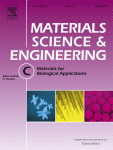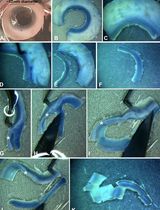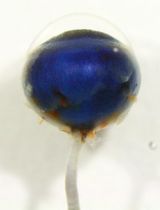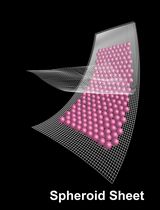- EN - English
- CN - 中文
Preparation of Amyloid Fibril Networks
淀粉样纤维网络的制备
发布: 2018年02月20日第8卷第4期 DOI: 10.21769/BioProtoc.2733 浏览次数: 8946
评审: Vivien Jane Coulson-ThomasChristopher J. PoonAnonymous reviewer(s)
Abstract
Networks of amyloid nanofibrils fabricated from common globular proteins such as lysozyme and β-lactoglobulin have material properties that mimic the extracellular microenvironment of many cell types. Cells cultured on such amyloid fibril networks show improved attachment, spreading and in the case of mesenchymal stem cells improved differentiation. Here we describe a detailed protocol for fabricating amyloid fibril networks suitable for eukaryotic cell culture applications.
Keywords: Amyloid fibrils (淀粉样纤维)Background
A wide variety of proteins and peptides can adopt non-native structures and aggregate into amyloid fibrils possessing a common cross β-sheet secondary structure (Nelson et al., 2005). Amyloid fibrils are the pathological hallmarks of a number of neurodegenerative diseases (Chiti and Dobson, 2006), however, there is a growing consensus that mature amyloid fibrils are non-toxic by-products and the toxic species are soluble oligomers, pre-fibrillar aggregates (Kayed et al., 2003), or perhaps the process of aggregation itself (Reynolds et al., 2011). Additionally, a number of functional amyloids with essential physiological features have been discovered in a wide range of organisms (including humans) (Chiti and Dobson, 2006).
Non-toxic synthetic amyloid fibrils can be made from inexpensive, readily available, food grade proteins (Jung et al., 2008; Lara et al., 2011) and have a number of important applications in a wide range of technologies (Dharmadana et al., 2017; Wei et al., 2017). For example 2D and 3D networks of amyloid fibrils have physical and mechanical properties that mimic the local microenvironment of many eukaryotic cells, namely the extracellular matrix (ECM), thus are promising biomimetic materials for cell culture applications (Reynolds et al., 2014 and 2015; Gilbert et al., 2017). Here we describe in detail a protocol to fabricate aqueous suspensions of amyloid fibrils and their subsequent adsorption onto solid supports where they have been shown to control cell adhesion (Reynolds et al., 2014), spreading (Reynolds et al., 2015) and direct the differentiation of Mesenchymal Stem Cells (MSCs) (Gilbert et al., 2017).
Materials and Reagents
- Personal Protective Equipment (PPE): Gloves (latex or nitrile), lab coat and safety glasses
- 15 ml polypropylene centrifuge tubes (Corning, catalog number: 430791 )
- Millex-GP Syringe Filter, 0.22 μm, Polyethersulfone, 33 mm diameter, non-sterile (Merck, catalog number: SLGP033NB )
- Syringe PP/PE without needle, Luer slip tip, 5 ml (Sigma-Aldrich, catalog number: Z116866 )
- Spectra/Por 1 RC Dialysis Membrane Tubing (6-8 kDa MWCO, 25.5 mm diameter) (Fisher Scientific, catalog number: 08-670C)
Manufacturer: Spectrum Medical Industries, catalog number: 132660 . - Dialysis tubing clamps (50 mm) (Sigma-Aldrich, catalog number: Z371092 )
- Pyrex crystallizing dish (used as oil bath) (Capacity 2.5 L) (diameter x height = 190 x 100 mm) (Corning, PYREX®, catalog number: 3140-190 )
- BRAND pipette tips (volume 0.1-20 μl), non-sterile (BRAND, catalog number: 732222 )
- Corning universal fit pipette tips, non-sterile, volume 1-200 μl (Corning, catalog number: 4865 ) and volume 100-1,000 μl (Corning, catalog number: 4867 )
- Muscovite Mica disks, grade V-1 diameter 12.5 mm (ProSciTech, catalog number: G51-12 )
- Double sided tape (for cleaving mica) (Agar Scientific, catalog number: AGG263 )
- Headspace glass vials (20 ml) (Sigma-Aldrich, catalog number: 27306 )
- β-Lactoglobulin from bovine milk ≥ 90% (PAGE), freeze-dried powder (Sigma-Aldrich, catalog number: L3908 )
- Lysozyme from chicken egg white ≥ 90%, freeze-dried powder (Sigma-Aldrich, catalog number: L6876 )
- Hydrochloric acid, ACS Reagent, 37% (Sigma-Aldrich, catalog number: 258148 )
- Sodium hydroxide, BioXtra, ≥ 98% Anhydrous Pellets (Sigma-Aldrich, catalog number: S8045 )
- Silicone oil (Sigma-Aldrich, catalog number: 85409 )
- Hanna pH standard buffer solutions, pH 10 (Sigma-Aldrich, catalog number: Z655155), pH 7 (Sigma-Aldrich, catalog number: Z655139)
Manufacturer: Hanna, catalog numbers: HI 6010 and HI 6007 . - Ricca Chemical Buffer, Reference Standard pH 1.68 (Fisher Scientific, catalog number: 1492-16 )
- 10% lysozyme (or β-Lactoglobulin) solution for purification (see Recipes)
- 2% lysozyme (or β-Lactoglobulin) solution for fibril formation (see Recipes)
Equipment
- BRAND glass beaker with spout 600 ml (BRAND, catalog number: 90648 )
- Hanna bench pH/ISE meter HI4222 (Sigma-Aldrich, catalog number: Z655333EU)
Manufacturer: Hanna Instruments, model: HI-4222 .
Note: This product has been discontinued. - Laboratory centrifuge (Sigma Laborzentrifugen, catalog number: Sigma 3-30KHS )
- 12159 rotor (Sigma Laborzentrifugen, catalog number: 12159 )
- Barnstead E-pure (MilliQ) Water Filtration Device (producing water with a resistivity of ≥ 18.2 MΩ) (Thermo Fisher Scientific, Thermo FisherTM, catalog number: D4631 )
- Labco digital hotplate stirrer (Labtek, catalog number: 400.100.105 )
Note: This product has been discontinued. - Spinbar magnetic stirrer bars PTFE coated polygon 60 x 8 mm (Sigma-Aldrich, catalog number: Z266353 ) and 12.7 x 3 mm (SP Scienceware - Bel-Art Products - H-B Instrument, catalog number: F37119-0127 )
- Aldrich Clamp Holder (Sigma-Aldrich, catalog number: Z243620 )
- Aldrich Benchclamp 3-prong (Sigma-Aldrich, catalog number: Z556645 )
- Support Stand with Rod (Sigma-Aldrich, catalog number: Z509442 )
- BRAND Ice bucket with lid 4.5 L (BRAND, catalog number: 156100 )
- Gilson PIPETMAN
Classic P20 max volume 20 μl (Gilson, catalog number: F123600 )
Classic P200 max volume 200 μl (Gilson, catalog number: F10005M )
Classic P1000 max volume 1,000 μl (Gilson, catalog number: F123602 ) - Martin Christ Alpha 1-2LDplus Entry Laboratory Freeze Dryer (Martin Christ, model: Alpha 1-2LDplus , catalog number: 101530), equipped with 50 ml single-neck round-bottom flasks (Sigma-Aldrich, catalog number: Z414484 )
- An air or nitrogen sauce (for drying samples, post rinse)
Procedure
文章信息
版权信息
© 2018 The Authors; exclusive licensee Bio-protocol LLC.
如何引用
Charnley, M., Gilbert, J., Jones, O. G. and Reynolds, N. P. (2018). Preparation of Amyloid Fibril Networks. Bio-protocol 8(4): e2733. DOI: 10.21769/BioProtoc.2733.
分类
干细胞 > 成体干细胞 > 间充质干细胞
生物化学 > 蛋白质 > 自组装
细胞生物学 > 细胞分离和培养 > 细胞生长
您对这篇实验方法有问题吗?
在此处发布您的问题,我们将邀请本文作者来回答。同时,我们会将您的问题发布到Bio-protocol Exchange,以便寻求社区成员的帮助。
提问指南
+ 问题描述
写下详细的问题描述,包括所有有助于他人回答您问题的信息(例如实验过程、条件和相关图像等)。
Share
Bluesky
X
Copy link












